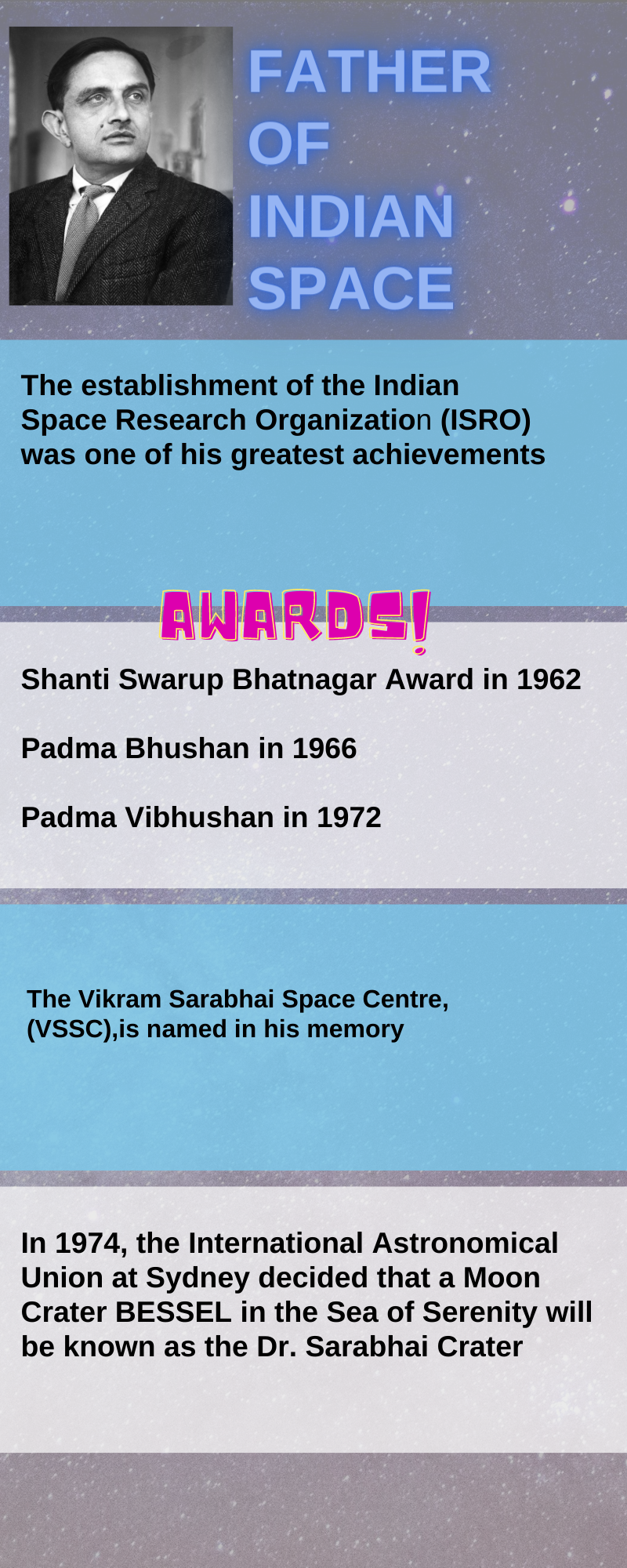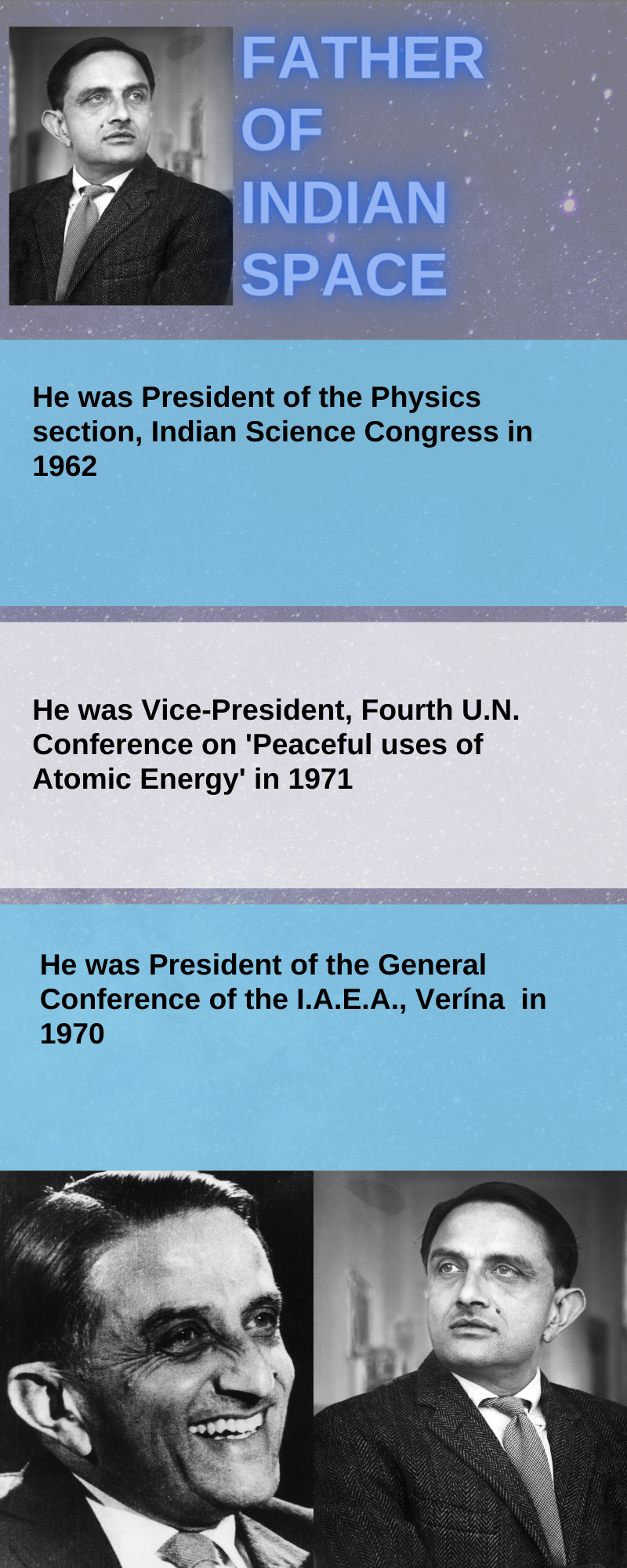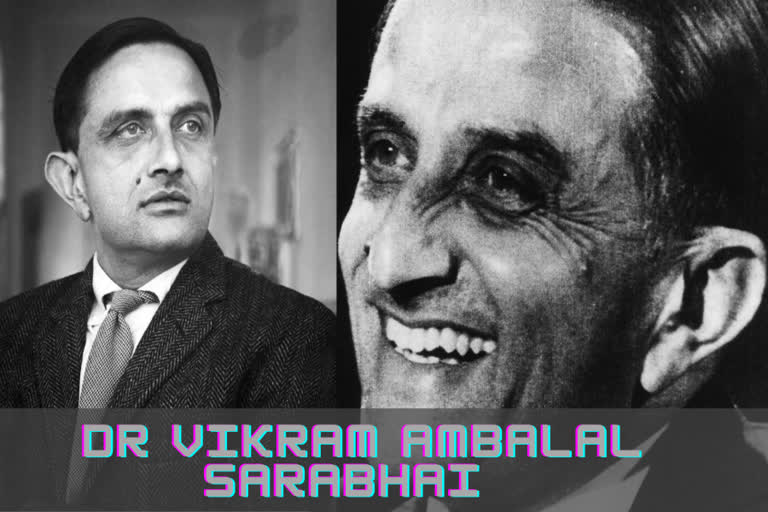Hyderabad: Dr. Vikram Ambalal Sarabhai was a great institution builder and helped to establish a large number of institutions in diverse fields. He was instrumental in establishing the Physical Research Laboratory (PRL) in Ahmedabad.His father Ambalal Sarabhai was an affluent industrialist and owned many mills in Gujarat. Vikram Sarabhai was one of the eight children of Ambalal and Sarla Devi. ISRO tweeted remembering Dr. Sarabahi on his birth anniversary:-
-
Paying tributes to the Father of the Indian Space Program, Dr. Vikram Ambalal Sarabhai on his birth anniversary.
— ISRO (@isro) August 12, 2020 " class="align-text-top noRightClick twitterSection" data="
Recently, Chandrayaan-2 captured the Sarabhai Crater on Moon. Read more here https://t.co/VQwS4HYh0g#VikramSarabhai pic.twitter.com/3MjLM3yTX5
">Paying tributes to the Father of the Indian Space Program, Dr. Vikram Ambalal Sarabhai on his birth anniversary.
— ISRO (@isro) August 12, 2020
Recently, Chandrayaan-2 captured the Sarabhai Crater on Moon. Read more here https://t.co/VQwS4HYh0g#VikramSarabhai pic.twitter.com/3MjLM3yTX5Paying tributes to the Father of the Indian Space Program, Dr. Vikram Ambalal Sarabhai on his birth anniversary.
— ISRO (@isro) August 12, 2020
Recently, Chandrayaan-2 captured the Sarabhai Crater on Moon. Read more here https://t.co/VQwS4HYh0g#VikramSarabhai pic.twitter.com/3MjLM3yTX5
He was greatly influenced by Mahatama Gandhi, Rabindranath Tagore, J Krishna Murthi, Motilal Nehru, V.S Shrinivasa Shashtri, Jawaharlal Nehru, Sarojini Naidu, Maulana Azad, C.F Andrews, and C.V Raman. His home was often visited by these personalities and interaction with them helped him build a character and interest in varied subjects.
- Sarabhai matriculated from the Gujarat College in Ahmedabad after passing the Intermediate Science examination. After completing his college education, he went to England to study at Cambridge University where he passed the Tripos examination of Natural Sciences.
- In 1947, he got PhD for his work on photofission (Cosmic Ray investigation in Tropical Latitudes) at the Cavendish Laboratory in Cambridge.
- He had a special interest in cosmic rays and thus his research is greatly influenced by this. He did research on cosmic rays for some time at the Poona Central Metrological Station and later went to Kashmir to continue his research.
- He also undertook research in cosmic rays under physicist Sir CV Raman at the Indian Institute of Science, Bangalore.
- Shortly after he returned from Cambridge, he established the Physical Research Laboratory at Ahmedabad. The Institute was devoted to the study of cosmic rays and outer space.
- In 1955, Sarabhai set up a branch of Physical Research Laboratory at Gulmarg in Kashmir. The Atomic Energy Department of the Government of India established a full-fledged High-Altitude Research Center at the same place.
- He was named as chairman of the Atomic Energy Commission of the Department of Atomic Energy of India. He is attributed to his contribution to taking India in space-age by expanding the Indian Space Research Organisation.
- The year 1957-1958 was designated as an International Geo-physical year (IGY). The Indian programme for the IGY had been one of the most significant ventures of Sarabhai. This gave him exposure to new vistas of space science with the launching of Sputnik-I in 1957.
- Sarabhai was also a pioneer of the pharmaceutical industry in India. He was among the very few in the pharmaceutical industry who recognized that the highest standards of quality should be established and maintained at any cost. It was Sarabhai who first implemented Electronic Data Processing and Operations Research Techniques in the pharmaceutical industry.
The establishment of the Indian Space Research Organization (ISRO) was one of his greatest achievements. He successfully convinced the government of the importance of a space program for a developing country like India after the Russian Sputnik launch.
Dr. Sarabhai emphasized the importance of a space program in his quote: "There are some who question the relevance of space activities in a developing nation. To us, there is no ambiguity of purpose. We do not have the fantasy of competing with the economically advanced nations in the exploration of the moon or the planets or manned space-flight. " But we are convinced that if we are to play a meaningful role nationally, and in the community of nations, we must be second to none in the application of advanced technologies to the real problems of man and society."
Dr. Homi Jehangir Bhabha, widely regarded as the father of India's nuclear science program, supported Dr. Sarabhai in setting up the first rocket launching station in India. This center was established at Thumba near Thiruvananthapuram on the coast of the Arabian Sea, primarily because of its proximity to the equator. After a remarkable effort in setting up the infrastructure, personnel, communication links, and launch pads, the inaugural flight was launched on November 21, 1963, with a sodium vapor payload.
Also Read: Remembering William Bateson, a believer of 'Mendelian Law' and known for coining the term 'Genetics'
As a result of Dr. Sarabhai's dialogue with NASA in 1966, the Satellite Instructional Television Experiment (SITE) was launched from July 1975 - July 1976 (when Dr.Sarabhai was no more).
Dr. Sarabhai started a project for the fabrication and launch of an Indian Satellite. As a result, the first Indian satellite, Aryabhata, was put in orbit in 1975 from a Russian Cosmodrome.
- He was also responsible for the establishment of the Space Science and Technology Centre at Thumba, Kerala, and the Experimental Satellite Communication Earth Station at Ahmedabad.
- The project, satellite Aryabhata was planned under his command which was launched in 1975.
- He established the Nehru Foundation for Development in 1963 for the study of social and educational problems. In the same year, he also established the Community Science Center which intended to spread knowledge, create interest, and promote experimentation among students, children, and the public related to science.
- He had also established the Ahmedabad Textile Industry's Research Association in 1947.
- Darpan Academy for Performing Arts, Ahmedabad (along with his wife)
- Vikram Sarabhai Space Centre, Thiruvananthapuram
- Space Applications Centre, Ahmedabad (This institution came into existence after merging six institutions/centers established by Sarabhai)
- Faster Breeder Test Reactor (FBTR), Kalpakkam
- Variable Energy Cyclotron Project, Calcutta
- Electronics Corporation of India Limited (ECIL), Hyderabad
- Uranium Corporation of India Limited (UCIL), Jaduguda, Bihar
Sarabhai was a man of deep cultural interests. He was interested in music, photography, archaeology, fine arts, and so on. With his wife Mrinalini, he established Darpana, an institution devoted to the performing arts.


He believed that a scientist should never shut himself up in an ivory tower or overlook the problems faced by the society in the mere academic pursuit of pure science. Sarabhai was deeply concerned with the state of science education in the country. To improve the same, he had established the Community Science Centre.
Also Read: M.S. Swaminathan, known as 'The Father of Green Revolution'



